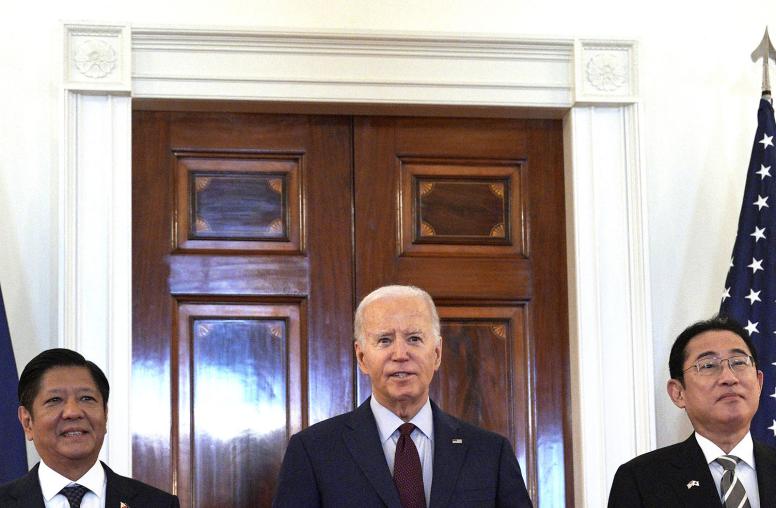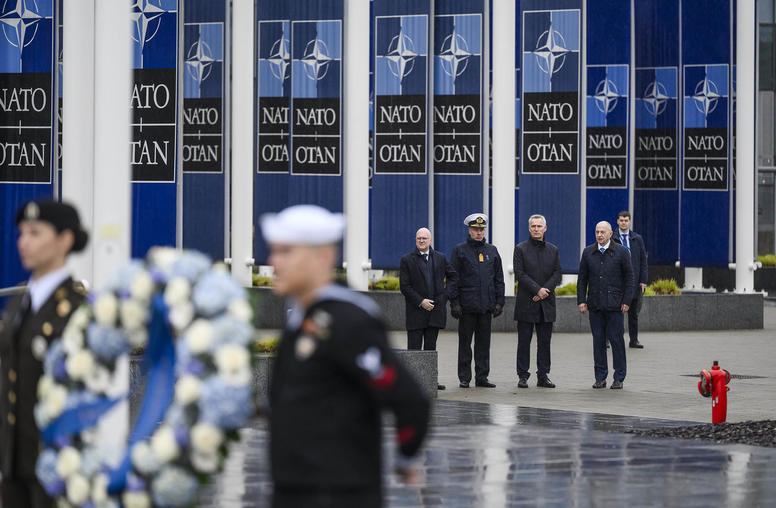On the Issues: North Korea’s Leadership Succession: The China Factor
USIP’s John Park outlines the development of China’s North Korea policy, and examines the implications of deepening Communist Party of China (CPC)-Workers’ Party of Korea (WPK) ties for this succession process and the U.S.’s North Korea policy.
September 28, 2010
On September 28, North Korean state media announced that Kim Jong-il’s third son, Kim Jong-eun, was promoted to the rank of four-star general just prior to the opening of the Workers’ Party of Korea conference. Kim Jong-eun was later named vice chairman of the Party’s Central Military Commission at the conference. These important developments follow the late August meeting between Chinese President Hu Jintao and North Korean leader Kim Jong-il in Changchun, near the Sino-DPRK border, which appears to have cleared the way for this Party conference. After the meeting, both countries’ state media reported the leaders’ support for the rising generation of the Party — a clear reference to Kim Jong-eun. The significance of the rare Party conference that began on September 28 is that a group of Party officials will be appointed by the delegates to essentially facilitate the leadership succession process.
USIP’s John Park outlines the development of China’s North Korea policy, and examines the implications of deepening Communist Party of China (CPC)-Workers’ Party of Korea (WPK) ties for this succession process and the U.S.’s North Korea policy.
- What is Xiaokang and how does it factor into China's North Korea policy?
- Why is fostering sustainable stability in Northeast Asia such a policy priority for China?
- How is China using economic engagement with North Korea to further its national interests?
- What are the implications of China’s “Two-Party Approach” in dealing with North Korea for the leadership succession process and the U.S.’ North Korea policy?
What is Xiaokang and how does it factor into China’s North Korea policy?
Xiaokang, China’s development policy of bringing the majority of the population into the middle class by 2020, has been the core objective of the CPC since it was introduced by Deng Xiaoping. Chinese leaders have tailored traditional foreign policy principles in order to further Xiaokang goals. They have placed specific emphasis on two essential factors to strengthen Xiaokang goals — a stable external environment on China’s borders and stable relations with the United States.
From this perspective, North Korea has constituted a major instability factor for China in Northeast Asia. At key moments since the early 1990s, North Korean instability — either due to massive natural disasters, ineffective economic policies, or acts of brinkmanship — has posed a major challenge to the secure environment required to achieve Xiaokang goals. To address this North Korean instability factor, Beijing tailored its two primary foreign policy principles — non-intervention in the internal affairs of other states and cooperation in multilateral institutions — to develop the “Four Sentences” that comprise its DPRK policy. The first is non-proliferation in Asia, a message directed to North Korea. The second is peaceful settlement through dialogue, a message directed to the United States. The third is peace and stability on the Korean Peninsula, a message directed to all parties. The fourth is the need to give necessary consideration to North Korea’s security concerns, a message directed to the United States.
Although the Four Sentences comprise Beijing’s long-term approach to the Korean Peninsula and remain unaltered, the means for achieving these objectives have changed considerably since the early 2000s. Beijing has become more proactive and entrepreneurial in its handling of the ongoing North Korean nuclear imbroglio. This trend culminated in the start of Beijing’s chairmanship of the newly launched Six-Party Talks in August 2003. Rather than a discreet behind-the-scenes approach that characterized its diplomatic activities during the 1994 North Korean nuclear crisis, Beijing adopted an overt posture and assumed significant political risk by chairing the Six-Party Talks process.
Why is fostering sustainable stability in Northeast Asia such a policy priority for China?
Xiaokang is a major factor – largely overlooked by analysts outside of China — in understanding why stabilizing North Korea constitutes a top policy priority for Beijing. Closely related to Xiaokang is the leadership’s need to promote social stability in China. In practical terms, this means closing the income gap between different regions in China as the country continues to develop. Among China’s chronically poorest provinces are the three closest to North Korea — Liaoning, Heilongjiang, and Jilin. By fostering sustainable stability in Northeast Asia, Beijing is seeking to facilitate sustainable economic development in these provinces. Beijing’s two primary means for doing so have been bolstering DPRK regime stability with Chinese political capital and promoting DPRK resource development for mutual benefit. We should not be surprised by this separate, parallel Sino-DPRK track that has no specific linkage to progress with DPRK denuclearization. China, like all countries, is seeking to further its national interests.
An important distinction is that Beijing conducted these bilateral efforts through its CPC International Liaison Department channel with North Korea. This has been part of an ongoing effort by Beijing to rebuild the Sino-DPRK relationship since ties were severed by Pyongyang in response to China’s establishment of diplomatic relations with Seoul in 1992. After a “lost decade” of frozen relations, Chinese overtures began to gain traction in the early 2000s. Vice Premier Wu Yi’s visit to Pyongyang in October 2005 for the 60th anniversary celebrations of the founding of the WPK marked a highpoint. The reason was the inclusion of Commerce Minister Bo Xilai who signed landmark bilateral agreements for the joint development of DPRK mineral resources.
Premier Wen Jiabao’s October 2009 visit to Pyongyang marked a further deepening of the CPC-WPK relationship. While the occasion was the 60th anniversary of founding of diplomatic relations, the significance lay in the comprehensive delegation that Wen headed. Among the Chinese delegation members were the commerce minister, the chief of the National Development and Reform Commission — the main architects and implementers of Chinese economic development — in addition to senior officials from the CPC International Liaison Department and the People’s Liberation Army. At present, China’s ambassador to Pyongyang, Liu Hongcai, is a vice minister in the CPC International Liaison Department and not a career diplomat like his predecessor, Liu Xiaoming.
How is China using economic engagement with North Korea to further its national interests?
The main message from Wen’s visit was that the CPC would bolster the stability of the WPK through a comprehensive bilateral relationship centered on expanding economic engagement. In practice, seeking to achieve the goals of Xiaokang and securing strong bilateral commercial ties have resulted in the creation of close localized connections between North Korea’s Hamgyong-buk-do and China’s Jilin province. The symbiotic relationship that exists between these two border provinces can be characterized as “Ham-Ji” — a sub-regional area where the border is relatively porous and facilitates coping mechanism-type activities through trade in nascent DPRK markets.
Given that China’s economic engagement — both at the local as well as party-to-party level — with North Korea is not directly linked to DPRK denuclearization activities, Pyongyang currently enjoys the benefits of its bilateral economic interactions with China without pressure to meet the immediate obligations of Six-Party Talks agreements. In a sense, Beijing’s North Korea policy has evolved to become a Chinese version of the “Sunshine Policy” initiated by the former ROK president Kim Dae-jung and carried on by his successor, Roh Moo-hyun.
The current sanctions regime against North Korea does not actually prohibit much of the commercial activities and economic linkages in which China is engaged. In the unique language of the U.N., both Security Council Resolutions 1874 and 1718 do not prohibit member states from engaging in economic development and humanitarian activities in North Korea, which is how Beijing characterizes its economic interactions. In practice, while financial sanctions continue to dominate Washington’s approach to dealing with Pyongyang, PRC state-owned enterprises and private firms have been expanding their interactions with DPRK state trading companies.
What are the implications of China’s “Two-Party Approach” in dealing with North Korea for the leadership succession process and the U.S.’ North Korea policy?
First, China has realized significant progress in the CPC-WPK track and bolstered North Korean stability. Innocuous Sino-DPRK “education, tourism and development” agreements signed by Premier Wen during his October 2009 Pyongyang visit are facilitating a host of follow-up deals. On July 30, PRC Ambassador Liu Hongcai and DPRK Foreign Trade Minister Ri Ryong–nam signed an economic and technical cooperation accord. Soon after, Special Adviser for Nonproliferation and Arms Control Robert Einhorn visited Seoul to seek South Korean cooperation on implementing Iran sanctions and discuss the “new” DPRK sanctions. While the intensifying CPC-WPK economic and political relationship creates a more stable context for leadership succession in Pyongyang, it raises serious questions about the efficacy of DPRK sanctions.
Second, China’s evolving North Korea policy constitutes one of two pillars in its “balanced Korean Peninsula” approach. It is highly unlikely that China will deviate from this approach and select one Korea over the other — even if there is a future North Korean provocation. The Cheonan incident sets a dangerous precedent where North Korea evaded military retaliation by South Korea and pressure from Beijing. A wrong message may have been sent to the emerging Party leadership group.
Third, the growing CPC-WPK partnership is taking place while Washington implements existing and “new” DPRK financial sanctions. An unintended consequence of this policy tool is that North Korea is becoming more dependent on China during an accelerated DPRK leadership succession process. The CPC appears to be investing considerable political capital and economic development assistance in the future generations of the WPK. The meeting between President Hu Jintao and Kim Jong-il in late August in Changchun marked another high point in CPC-WPK relations as Pyongyang prepared a rare Party conference in September. Yet there have been no Chinese references of explicit linkage between deepening party-to-party ties and progress with North Korean denuclearization. By going further down this delinked Two-Party path during an unfolding succession process, Beijing is casting a growing shadow over Washington’s stalemated denuclearization-centered North Korea policy.



